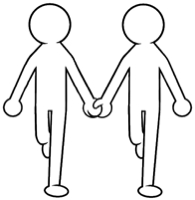
|
The Society of Folk Dance Historians (SFDH)
Basic Steps By Don Buskirk
YouTubes illustrating or amplifying the topic discussed are
[
Home |
About |
Encyclopedia | CLICK AN IMAGE TO ENLARGE |

|
The Most Basic Dance Patterns – S,Q,Q; Q,Q,S; Q,S; S,Q; S,S,Q,Q,S
Dance ethnochoreologists [I believe that's the official term for those who study ethnic dance] have long talked about a nearly universal [at least in Europe and West Asia] a six-step pattern – step, step, step, __, step, __ – where 'step' can mean a weighted step in any direction, and '___' means a touch, lift, kick, hop, pause – any non-weighted foot action [or inaction]. Usually, the pattern adds up to three pairs of steps – the first pair in one direction, the second in the same direction, and the third in the opposite direction – two forward, one back. Some prefer to describe the pattern and leave it at that; I have attached a name to the genre – the Taproot Dance.
Uneven Walking – S,Q,Q, – Slow, Quick, Quick
I call the pattern Uneven Walking. Basically, the pattern is walking – right, left, right, left, etc. The only difference from regular walking is, some steps take longer than others. For instance, outside the big cities, the most pervasive and common dance in Greece today is [and maybe always has been] Syrto, which is walking to a S,Q,Q, rhythm. Syrto has many other names, and there are a surprisingly large number of ways to 'walk.' but the basic principle is the same – every step carries weight – no kicks, leaps, pauses. Steps always alternate feet R,L,R,L,R,L,R,L, no matter what the speed or direction. Of course, dances based on Uneven Walking often include variations that add non-walking elements (like hops), but I still consider the dance in the Uneven Walking category because that's its 'default' choreography.
The Taproot Dance (S,Q,Q), or its variants is the most basic, common, widespread, dance in many countries in the Balkans, Anatolia, and the Levant – but not all. Greece, Albania, and Bulgaria, for instance, have another, even more basic, common, and widespread dance. The dance [S,S,S,__,S,__) is extremely simple [even simpler than the Taproot Dance], and that simplicity signifies its possible importance – could it be our most ancient dance pattern? Many Greeks think so!
Comment
John Uhlemann
The St. Louis Bulgarian community does the solo/couple Râčenica in a variety of styles depending on what part of Bulgaria they come from. It is definitely not a children's dance here. I was in a wedding in the village of Amara in Romania, north-west of Dobrogea, some years ago, and the Geamparele was popular, with couples in the center and everyone else in a circle around them doing simple 1,2,3s. I understand the dance has spread north almost to Bucovina.
Basic Steps – The Taproot Dance
From Don Buskirk's website, Folkdance Footnotes.
Used with permission.
This page © 2023 by Ron Houston.
Please do not copy any part of this page without including this copyright notice.
Please do not copy small portions out of context.
Please do not copy large portions without permission from Ron Houston.